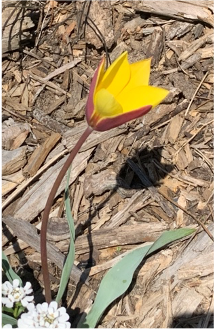Perennial Tulips – Tulipa Clusiana
go.ncsu.edu/readext?824376
en Español / em Português
El inglés es el idioma de control de esta página. En la medida en que haya algún conflicto entre la traducción al inglés y la traducción, el inglés prevalece.
Al hacer clic en el enlace de traducción se activa un servicio de traducción gratuito para convertir la página al español. Al igual que con cualquier traducción por Internet, la conversión no es sensible al contexto y puede que no traduzca el texto en su significado original. NC State Extension no garantiza la exactitud del texto traducido. Por favor, tenga en cuenta que algunas aplicaciones y/o servicios pueden no funcionar como se espera cuando se traducen.
Português
Inglês é o idioma de controle desta página. Na medida que haja algum conflito entre o texto original em Inglês e a tradução, o Inglês prevalece.
Ao clicar no link de tradução, um serviço gratuito de tradução será ativado para converter a página para o Português. Como em qualquer tradução pela internet, a conversão não é sensivel ao contexto e pode não ocorrer a tradução para o significado orginal. O serviço de Extensão da Carolina do Norte (NC State Extension) não garante a exatidão do texto traduzido. Por favor, observe que algumas funções ou serviços podem não funcionar como esperado após a tradução.
English
English is the controlling language of this page. To the extent there is any conflict between the English text and the translation, English controls.
Clicking on the translation link activates a free translation service to convert the page to Spanish. As with any Internet translation, the conversion is not context-sensitive and may not translate the text to its original meaning. NC State Extension does not guarantee the accuracy of the translated text. Please note that some applications and/or services may not function as expected when translated.
Collapse ▲Did you know that the tulip is a member of the lily family and is closely related to the onion? Did You Know that the Tulip is the only cut flower that continues to grow in the vase, often adding up to three inches to its original length? Have you ever been told that “You can’t grow tulips in the South” Well… the last one isn’t really true, although some folks think so.
The United States remains the top importer of tulips and receives one billion – (yes, billion) of them annually from the Dutch. However, the Netherlands is not their place of origin. The tulip probably is native to the Tien-Shan and Pamir Alai Mountain Ranges of central Asia near the modern day city of Islamabad, close to the border of Russia and China.
Once the most expensive flower in the world, Tulip bulbs commanded unbelievable prices and only the wealthy could afford them. They quickly became a status symbol and wealthy Dutch and European nobles invested heavily and paid big bucks for them. Speculation in tulips ran wild as people purchased bulbs for shockingly large sums with the hope of selling them for even more. As a result, many individuals suddenly became wealthy, spinning up the speculation even more. Just like the dot-com stock market speculation bubble – the bubble burst and the tulip trade tanked.
While some species of this beautiful bulb are best grown as annuals because of our relatively short springs, limited chill hours and hot weather, others with a slightly different kind of beauty perennialize well for us, marking early spring with vibrant colors. Growing 8 to 10 inches tall, the Tulipa clusiana ‘Cynthia’ species tulips are among the first bulbs to bloom.
Tulipa Clusiana var. chrysantha shown above is a nice small tulip for the rock  garden. Also known as Lady Tulips, these smaller and shorter species tulips naturalize much better than large-flowered Dutch hybrids. The variety ‘Cynthia’ has red petals edged with chartreuse.
garden. Also known as Lady Tulips, these smaller and shorter species tulips naturalize much better than large-flowered Dutch hybrids. The variety ‘Cynthia’ has red petals edged with chartreuse.
The flowers only open after an hour or more of bright light, and are truly striking when stretched wide and flat to greet the sun, the inside showing none of the red coloration glowing on the outside of the flower. They just shout “Happy Spring!”
This is my first year with these beauties, and I love a non-fussy plant with gorgeous, bright blooms. These bulbs should be planted in the fall at a depth equal to three times in their diameter and 2 feet apart. After spring blooming they should be fertilized and the foliage allowed to mature and die. Bulbs should not be disturbed the rest of the year.
Minda Daughtry is the Horticulture Agent for North Carolina Cooperative Extension in Lee County.




